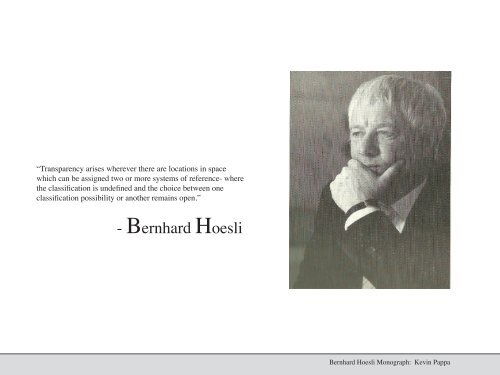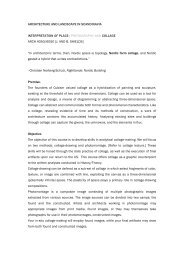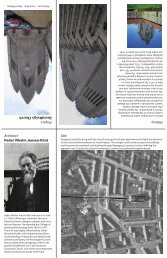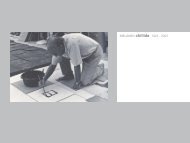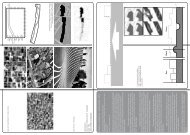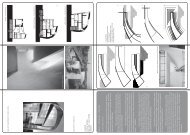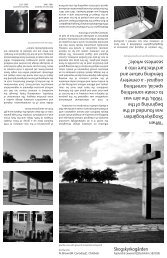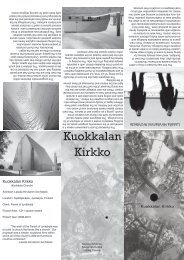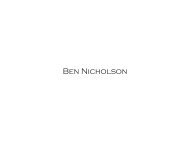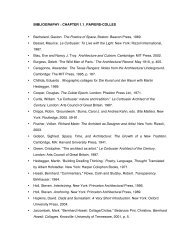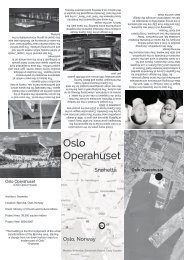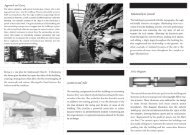- Bernhard Hoesli - collage and architecture
- Bernhard Hoesli - collage and architecture
- Bernhard Hoesli - collage and architecture
You also want an ePaper? Increase the reach of your titles
YUMPU automatically turns print PDFs into web optimized ePapers that Google loves.
“Transparency arises wherever there are locations in space<br />
which can be assigned two or more systems of reference- where<br />
the classification is undefined <strong>and</strong> the choice between one<br />
classification possibility or another remains open.”<br />
- <strong>Bernhard</strong> <strong>Hoesli</strong><br />
<strong>Bernhard</strong> <strong>Hoesli</strong> Monograph: Kevin Pappa
F. LEGER “The Gray Root” c.1953<br />
B. HOESLI “No. 13” c.1964<br />
Formation of Pedagogy<br />
<strong>Bernhard</strong> <strong>Hoesli</strong> was born on January 13th, in 1923 in<br />
Zurich, Switzerl<strong>and</strong> to parents that owned a road construction<br />
company. After earning a degree in <strong>architecture</strong> from ETH he<br />
began working at Le Corbusier’s studio in Paris <strong>and</strong> Marsaille.<br />
While in Paris he studied painting under Fern<strong>and</strong> Leger who is<br />
largely responsible for the development of the Section d’Or, or<br />
Golden Section. Leger’s mentorship left evidence in some of<br />
<strong>Hoesli</strong>’s earlier <strong>collage</strong> works like No.13. Here similarities arise<br />
in the balance between the shallow <strong>and</strong> deep space. Through a<br />
diagrammatic lens both compositions are arrangements of figures,<br />
relatively in the same plane, in front of a secondary field. Both<br />
also have a major <strong>and</strong> minor grain, which begins to speak to the<br />
overlapping nature present in so many of <strong>Hoesli</strong>’s <strong>collage</strong>s.<br />
<strong>Bernhard</strong> <strong>Hoesli</strong> Monograph: Kevin Pappa<br />
<strong>Bernhard</strong> <strong>Hoesli</strong> Monograph: Kevin Pappa
In 1951, he began his influential career in education<br />
by becoming a professor at the School of Architecture at the<br />
University of Texas at Austin. Alongside Colin Rowe <strong>and</strong> Robert<br />
Slutzky, the Texas Rangers changed the face of architectural<br />
education in the United States <strong>and</strong> Switzerl<strong>and</strong>. Rowe <strong>and</strong><br />
Slutzky’s definition of transparency laid groundwork for <strong>Hoesli</strong>’s<br />
teaching curriculum based on the use of precedents. At Texas a<br />
major pedagogical goal was identifying <strong>and</strong> teaching the language<br />
of Modern Architecture, <strong>and</strong> cubism was a key to that language.<br />
The normal precise wash renderings at the Ecole de Beaux Arts<br />
led to an <strong>architecture</strong> lacking in rigor. He began to rationalize<br />
<strong>and</strong> propagate the works of Cezanne <strong>and</strong> other cubists as a new<br />
language for demonstrating that rigor. Flattened, angular, <strong>and</strong><br />
spatial abstractions of the space-mass continuum led to more<br />
justifiable compositions. <strong>Hoesli</strong> believed that cubism’s synthesize<br />
of figure <strong>and</strong> field rather than its fracture was the requisite<br />
characteristic of Modern Architecture.<br />
In 1956 the director of the School of Architecture at UT<br />
resigned causing a fallout of many of the Texas Rangers. <strong>Hoesli</strong><br />
returned to Switzerl<strong>and</strong> <strong>and</strong> began teaching the first year courses<br />
at the ETH in Zurich. From 1959 until 1981 he directed the first<br />
year design program – the Grundkurs – at the ETH. <strong>Hoesli</strong>’s<br />
pedagogical revolution became part of the permanent structure of<br />
the curriculum as he involved himself in practically all aspects of<br />
the <strong>architecture</strong> program. At the same time, he ran a Zurich firm<br />
with Werner Aebli between 1960 <strong>and</strong> 1970 while also serving as<br />
Chairman of the Architecture Department of the ETH. In 1972, he<br />
barely survived nearly fatal injuries from a car accident until his<br />
unexpected death in 1984. He was 61 years old.<br />
<strong>Bernhard</strong> <strong>Hoesli</strong> Monograph: Kevin Pappa
Collage Methodology<br />
His early <strong>collage</strong> work suggests that they were some<br />
form of retreat from <strong>and</strong> perhaps an opposition to the hardedged<br />
abstractions of modern <strong>architecture</strong>. It can be seen<br />
as his personal way of exploring the manipulation of space<br />
through the eyes of both the architect <strong>and</strong> the painter.<br />
However, a greater architectural overtone comprised of figure<br />
– field relationships exists. Compositions are organized by<br />
subtle overlappings, feathering of edges, <strong>and</strong> ambiguous depth<br />
cues. Often it is difficult to tell which planar elements advance<br />
<strong>and</strong> which recede.<br />
<strong>Hoesli</strong> also implements an assortment of materials in<br />
the <strong>collage</strong>s. References to Papier Colle are best exemplified<br />
through torn <strong>and</strong> cut fragments of paper along with graphic<br />
clippings from periodicals. Layers of throwaway materials<br />
like cardboard, blocks of discarded wood, <strong>and</strong> common<br />
household materials prevent any notions of high art. A bias<br />
towards the avante-garde Art Informal style at the time is<br />
clarified by his incorporation of plain <strong>and</strong> otherwise useless<br />
materials. These haptic materials speak to the significance of<br />
chance <strong>and</strong> time in his design process. It is important to note<br />
<strong>Hoesli</strong>’s classification of a successful <strong>collage</strong>.<br />
<strong>Bernhard</strong> <strong>Hoesli</strong> Monograph: Kevin Pappa
“So a <strong>collage</strong> is not only meant as an object,<br />
something made, a result, but what is perhaps far more<br />
interesting: a process. Moreover, that behind this way<br />
of doing something which as a result then leads to a<br />
<strong>collage</strong>, the <strong>collage</strong> could be meant as an attitude of<br />
mind…”<br />
<strong>Hoesli</strong>’s works are literally <strong>and</strong> figuratively layered<br />
to reveal their material composition <strong>and</strong> methods of<br />
fabrication. Surface materials are often exposed as<br />
defined shapes trapped between other layers in the<br />
composition. This creates a reversal of figure <strong>and</strong><br />
ground. Interrupted complex grids <strong>and</strong> patterns,<br />
thick built up materials, <strong>and</strong> textures set against sharp<br />
disharmonies <strong>and</strong> discontinuities eventually become<br />
synonyms to what he found challenging <strong>and</strong> generative<br />
in architectural design.<br />
<strong>Bernhard</strong> <strong>Hoesli</strong> Monograph: Kevin Pappa
Collage & Architecture<br />
For example, No. 2 is composed of a cluster of wood<br />
blocks that overlap two base levels, one raised, <strong>and</strong> a<br />
lower contoured beach-like level. At first glance, one<br />
may mistake this for an architectural model. Instead,<br />
the composition is juxtaposed against an alternative<br />
shallow sculptural relief. Paper covers multiple<br />
connections between masses which masques discrete<br />
building-like volumes. Wood grain of certain surfaces<br />
is not present, further denying the fact that they are<br />
architectural elements. The contrast between a shallow<br />
relief <strong>and</strong> architectural model sets up a dialogue<br />
between two-dimensional <strong>and</strong> three-dimensional<br />
space or a play of phenomenal transparency. The<br />
quiet monumentality present in several of his <strong>collage</strong>s<br />
corresponds to his <strong>architecture</strong>. In the case of the<br />
Reynolds House, rectilinear <strong>and</strong> angles shapes respond<br />
to the site while the material palette dramaticizes the<br />
dialogue between earth <strong>and</strong> sky.<br />
<strong>Bernhard</strong> <strong>Hoesli</strong> Monograph: Kevin Pappa
In <strong>collage</strong> No. 26 a scaled hierarchy of differentiated<br />
elements begins to imply the plan of a Catholic Church<br />
in Glattbrugg, Switzerl<strong>and</strong>. Here <strong>Hoesli</strong> features the<br />
pre-existing temporal qualities of the site. An old<br />
bell tower along the street for example, like a found<br />
object in <strong>collage</strong>, is integrated by means of a diagonal<br />
alignment with the church.<br />
<strong>Bernhard</strong> <strong>Hoesli</strong> Monograph: Kevin Pappa
Le Corbusier’s void-solid reversal painting is an<br />
impressive example of the spatial clamping together of<br />
external <strong>and</strong> internal - the mass-space continuum. This<br />
overall relationship can be applied to works like Villa<br />
Currutchet in La Plata, Argentina. Here interior <strong>and</strong><br />
exterior spaces have sectional dialogues similar to Le<br />
Corbusier’s painting.<br />
<strong>Bernhard</strong> <strong>Hoesli</strong> Monograph: Kevin Pappa
Interpretation<br />
At the foundation of <strong>Hoesli</strong>’s work was the concept of temporality.<br />
His <strong>collage</strong>s were only momentarily completed, not finished or<br />
inviolable works. He frequently revisited the <strong>collage</strong>s at later dates,<br />
sometimes up to 15 years, <strong>and</strong> would pursue new ideas not stressed<br />
in the previously ‘completed’ <strong>collage</strong>. These ideas may be lingering<br />
in his mind or on the back of many of his works. Personal sketch<br />
fragments, comments, <strong>and</strong> dates were haphazardly arranged for future<br />
reference. On a concrete retaining wall leading to the garage at his<br />
house, he intermittently worked for many years on an ongoing outdoor<br />
<strong>collage</strong>. Exchanges between <strong>Hoesli</strong>, v<strong>and</strong>als, <strong>and</strong> the weather has<br />
unfortunately left no physical or photographic record. Confrontations<br />
between disparate elements <strong>and</strong> the return to old work encompass his<br />
underlying idea of impermanence. <strong>Hoesli</strong>’s unique style of updating<br />
keeps alive disturbing but productive questions <strong>and</strong> doubts. Who<br />
knows what came first – the unanswered question or the <strong>collage</strong>s?<br />
“I am impatient…with the interminable insistence on the undeniable<br />
perceptual differences between the buildings by F.L. Wright, Le<br />
Corbusier, <strong>and</strong> Mies.”<br />
<strong>Bernhard</strong> <strong>Hoesli</strong> Monograph: Kevin Pappa
<strong>Hoesli</strong>’s <strong>collage</strong>s were personal explorations that<br />
reveal a lot about his way of seeing <strong>and</strong> working.<br />
They brought up challenges interpreted as testing<br />
grounds for the design process he implemented<br />
in teaching. <strong>Hoesli</strong>’s commentary in the<br />
seminal Transparency essay is more concise <strong>and</strong><br />
applicable than Rowe <strong>and</strong> Slutzky’s overly specific<br />
comparisons. For <strong>Hoesli</strong>, “this was a matter of<br />
implied as opposed to literal visual continuities<br />
<strong>and</strong> overlaps, <strong>and</strong> the perception of deep space<br />
constantly opposed to the implication of shallow<br />
space.” Transparency allows us to see structures<br />
through a lens independent of the differences<br />
between historical <strong>and</strong> modern – a tool for the<br />
production of complex systems of order during the<br />
design process.<br />
“Collage was not the celebration of our victory over<br />
modernity. It was living out the true promise of<br />
modernity as something both existentially fateful<br />
<strong>and</strong> socially cohesive.”<br />
<strong>Bernhard</strong> <strong>Hoesli</strong> Monograph: Kevin Pappa


